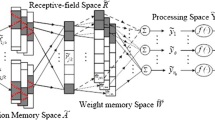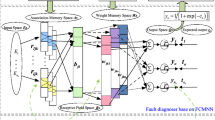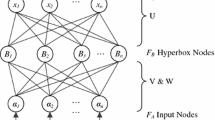Abstract
Traditionally, machine condition is described as a dichotomous problem: normal or failure. In fact, machines go through a series of degrading states until failure occurs. Degrading states do not make machines breakdown, but they do decrease performance reliability and increase the potential for faults and failures. In this paper, a neural network approach based on fuzzy cerebellar model articulation controller (FCMAC) is proposed to analyze machine degradation severity. Two kinds of situations are discussed: (1) machine signature from different levels of degradation severity are available to train the network; (2) machine signature from only normal perfect state are available to train the network. A degradation index is developed to reflect the degradation degree. The FCMAC network works as a ‘classifier’ or a ‘condition discriminator’ in these two situations. An example is presented to demonstrate this method and the results show that the FCMAC network is capable of ranking machine degradations quantitatively in both situations. With degradation analysis, maintenance activities can be implemented before failure eventually occurs, thus preventing fatal breakdowns more effectively.
Similar content being viewed by others
References
Mitchell L, Michael T (2001) Open standards for condition-based maintenance and prognostic systems, http://www.osacbm.org/documents/training/trainingmaterial/trainingdocument/osacbm\_training\_outline\_ver48.pdf
Djurdjanovic D, Lee J, Ni J (2003) Watchdog agentan infotronics-based prognostics approach for product performance degradation assessment and prediction. Adv Eng Info 17:109–125
Lee J (2001) E-intelligence strategies for product and manufacturing innovation. Transaction of Chinese Mechanical Engineer 12(5):526–531
Lee J (1999) Machine performance assessment methodology and advanced service technologies. In: Report of 4th annual symposium on frontiers of engineering. National Academy Press, Washington DC, pp 75–83
Qiu H, Lee J, Lin J, Yu G (2003) Robust performance degradation assessment methods for enhanced rolling element bearing prognostics. Adv Eng Info 17:127–140
Yu G, Qiu H, Djurdjanovic D, Lee J (2004) Performance prediction using recurrent neural network modeling with confidence bounds. In: Proceedings of the IMS International Conference, Arkes, France
Wang SW, Jiang ZM (2004) Valve fault detection and diagnosis based on CMAC neural networks. Energ Build 36:599–610
Albus JS (1975b) A new approach to manipulator control: the Cerebellar Model Articulation Controller (CMAC). J Dyn Syst Meas Control pp 220–228
Albus JS (1975a) Data storage in the Cerebellar Model Articulation Controller (CMAC). J Dyn Syst Meas Control pp 228–233
Chiang CT, Shin LC (1995) Integration of CMAC and radial basis function techniques. In: IEEE International Conference on Systems, Man and Cybernetics-Systems for the 21st-Century, vol. 4, pp 3263–3268
Intelligent Automation Inc. (1994) Fuzzy CMAC neural networks and application to flight vehicle control phase 1: technical report to ballistic missile defense organization. Tech. rep.
Su SF, Tao T, Hung TH (2003) Credit assigned CMAC and its application to online learning robust controllers. IEEE Trans Sys Man Cybern, Part B, Cybern 33(2):202–213
Paulo EMA, Godoy S (2003) Parametric CMAC networks: fundamental and applications of a fast convergence neural structure. IEEE Trans Ind Appl 39(5):1551–1557
Horvath G (2004) Kernel CMAC with improved capability. In: Proceedings Of IEEE International Joint Conference On Neural Networks, vol. 1, pp 681–686
Shun Feng S, Zne Jung L, Wang YP (2006) Robust and fast learning for fuzzy cerebellar model articulation controllers. IEEE Trans Sys Man Cybern, Part B Cybern 36(1):203–208
Miller WT, Hewes PR, Glanz FH (1990) Real-time dynamic control of an industrial manipulators using a neural network-based learning controller. IEEE Transactions on Robot Automation 6(1):1–9
Hung CP, Wang MH (2004) Diagnosis of incipient faults in power transformers using CMAC neural network approach. Elec Power Syst Res 71:235–244
Pan G, Xu H, Kwan CM, Liang C, Haynes L, Geng Z (1996) Modelling and intelligent chatter control strategies for a lathe machine.Contr Eng Pract 4(12):1647–1658
Lee J (1996a) Analysis of machine degradation using a neural network based pattern discrimination model. J Manuf Syst 12(5):379–391
Lee J (1996b) Measurement of machine performance degradation using a neural network model. Comput Ind 30:193–209
Lin CC, Wang HP (1996) Performance analysis of rotating machinery using enhanced cerebellar model articulation controller (e-cmac) neural networks. Comput Ind Eng 30(2):227–242
Author information
Authors and Affiliations
Corresponding author
Rights and permissions
About this article
Cite this article
Xu, RZ., Xie, L., Zhang, MC. et al. Machine degradation analysis using fuzzy CMAC neural network approach. Int J Adv Manuf Technol 36, 765–772 (2008). https://doi.org/10.1007/s00170-006-0887-6
Received:
Accepted:
Published:
Issue Date:
DOI: https://doi.org/10.1007/s00170-006-0887-6




